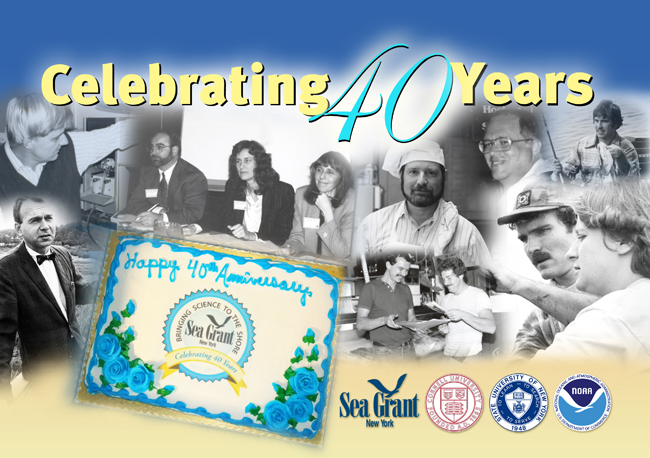On November 1, 1971, The New York Times ran the headline “New York Sea Grant Program Receives Initial Funding.” New York State had just received its first $600,000 grant under the new National Sea Grant Program and funding would be used to explore development of the state’s thousands of miles of coastlines along the Atlantic Ocean, and Lakes Erie and Ontario. This was the start of New York Sea Grant’s 40-year tradition of choosing only the best high quality research projects and disseminating the results through a specialized extension staff. Just how did this come about?
In the 1960s, our nation was in the throes of social upheaval paired with unprecedented scientific advances. Rachel Carson’s book, Silent Spring, had begun to raise our awareness about the environment. Many proclaimed Lake Erie to be dead. Our nation’s technological machinery was moving at a breakneck pace ever since President John F. Kennedy challenged Americans to put a man on the moon by decade’s end. But compared to the space race, ocean exploration was back at the starting gate.
Things were about to change. In 1966, the National Sea Grant College Program was born by Act of Congress with a goal of initiating and supporting education, research and outreach programs to impart useful information to people working with marine and Great Lakes resources, the scientific community and the general public. By decade’s end, New York became eligible for funding under the National Sea Grant College Act. Dr. Donald F. Squires at the State University at Stony Brook was the program’s first director.
New York Sea Grant was developed as a cooperative program of the State University of New York (SUNY) and Cornell University, the state’s federally designated Land Grant College, and had offices and personnel across the state. New York Sea Grant is one of 32 designated programs federally funded under the National Oceanic and Atmospheric Administration (NOAA) within the U.S. Department of Commerce. Today’s forward-thinking goals revolve around the themes of healthy coastal ecosystems, sustainable coastal development, safe and sustainable seafood, and hazard resilience in coastal communities.
What better way to celebrate the first 40 years than by organizing events that highlighted how our partners, stakeholders, researchers, educators and elected officials have helped us “bring science to the shore” for our mutual benefit? Fortieth exhibits were set up at the International Association for Great Lakes Research conference (Duluth, MN), the Great Lakes Research Consortium (Syracuse) and at the state capital (Albany Day). In the metro New York area, 40th displays were seen at the New York Marine Consortium conference (Columbia’s Lamont-Doherty Earth Observatory), the State of Jamaica Bay conference (Brooklyn College) and the New England Estuarine Research Society conference (Port Jefferson). With numerous Fall 2011 events that educated our supporters, we bring you some highlights in this special Winter 2012 issue of NY Coastlines. Be sure to check out videos of these lively events on our YouTube channel.
– Barbara A. Branca
On YouTube ...
- NYSG@40: 2011 Statewide Highlights (February 2012) More>
- NYSG@40: A Look at our Extension Program (February 2012) More>

Clockwise from bottom left: former dir. Dr. Donald F. Squires, researcher Dr. Joseph Makarewicz (SUNY Brockport), NYSG Fisheries Spec. Dave MacNeill, Asst. Dir. Cornelia Schlenk, former dir. Dr. Anne McElroy (SBU), former assoc. dir. Dr. Mike Voiland (NCSG), former dir. Dr. Bob Malouf (ret. Oregon SG), former assoc. dir. Dale Baker (Cornell), former scholar Karen Chytalo (NYSDEC), former scholar/asst. dir. Bill Wise (SoMAS), seafood retailer George Wefelman, NYSG Seafood Spec. Ken Gall. Photo collage by Loriann Cody